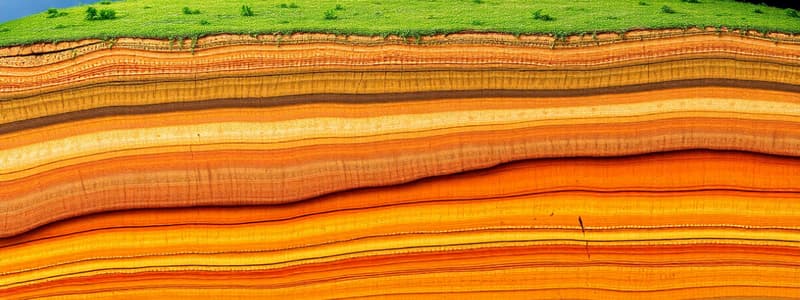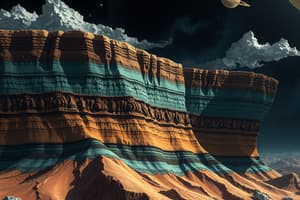Podcast
Questions and Answers
What substance primarily makes up the Earth's crust?
What substance primarily makes up the Earth's crust?
- Rock (correct)
- Liquid iron
- Semi-solid magma
- Solid metal
What are the two components of the Earth's core?
What are the two components of the Earth's core?
- Solid inner core and liquid outer core (correct)
- Gaseous atmosphere and solid surface
- Metallic crust and rocky mantle
- Liquid inner core and solid outer core
Which layer of the Earth is primarily a semi-solid magma layer?
Which layer of the Earth is primarily a semi-solid magma layer?
- Core
- Atmosphere
- Mantle (correct)
- Crust
Which of the following statements about Earth's layers is true?
Which of the following statements about Earth's layers is true?
How many layers make up the Earth's rocky portion?
How many layers make up the Earth's rocky portion?
What primarily constitutes the inner core of the Earth?
What primarily constitutes the inner core of the Earth?
How does the temperature of the inner core compare to its pressure?
How does the temperature of the inner core compare to its pressure?
What role does the outer core play in Earth's magnetism?
What role does the outer core play in Earth's magnetism?
Which layer of the Earth is considered the largest by volume?
Which layer of the Earth is considered the largest by volume?
What is the main characteristic of the mantle's asthenosphere?
What is the main characteristic of the mantle's asthenosphere?
What happens in the central mantle, also known as the transition zone?
What happens in the central mantle, also known as the transition zone?
Why is the lower mantle considered more solid than the other mantle layers?
Why is the lower mantle considered more solid than the other mantle layers?
What feature characterizes the Earth's crust?
What feature characterizes the Earth's crust?
What are tectonic plates comprised of?
What are tectonic plates comprised of?
What defines the lithosphere?
What defines the lithosphere?
Flashcards
Earth's Crust
Earth's Crust
The Earth's outermost layer composed of solid rock. It's where we live, plants grow, and animals roam.
Earth's Mantle
Earth's Mantle
A semi-solid layer beneath the crust, mostly made of iron, magnesium, and silicon. It's like a thick, gooey layer of melted rock.
Earth's Core
Earth's Core
The Earth's center, composed of two parts: a solid, extremely hot inner core and a liquid outer core primarily made of iron and nickel.
Earth's Inner Core
Earth's Inner Core
Signup and view all the flashcards
Earth's Outer Core
Earth's Outer Core
Signup and view all the flashcards
Asthenosphere
Asthenosphere
Signup and view all the flashcards
Transition Zone (Central Mantle)
Transition Zone (Central Mantle)
Signup and view all the flashcards
Lower Mantle
Lower Mantle
Signup and view all the flashcards
Lithosphere
Lithosphere
Signup and view all the flashcards
Tectonic Plates
Tectonic Plates
Signup and view all the flashcards
Study Notes
Earth's Three Main Layers
- The Earth's rocky layers consist of the crust, mantle, and core
- These layers are similar to those found on other rocky planets
- The core is composed of an inner solid iron core and an outer molten iron core
- The core is denser than the mantle and crust
Crust
- The outermost layer of the Earth
- It’s where life exists
- Thin layer, averaging about 20 miles thick
- Thinner under oceans (about 3 miles)
- Thicker under mountains
- Composed of rocks, minerals, and metals
- The crust is broken into multiple tectonic plates that move
- These moving plates cause earthquakes, volcanoes, and mountains
- The lithosphere is a section of the crust and upper mantle that is constantly moving
Mantle
- The layer between the crust and core, making up 84% of the Earth's volume
- Semi-solid layer, with flowing molten iron, magnesium, and silicon
- Extends from about 20 to 1800 miles below the surface
- Consists of layers like the asthenosphere, central mantle (transition zone), and lower mantle
- The asthenosphere (upper mantle) is semi-molten and moves in convection currents influencing tectonic plates movement.
- The central mantle (transition zone) has denser rocks and significant water content (hydroxide)
- The lower mantle is the hottest and densest part of the mantle, largely solid.
Core
- Located at the center of the Earth
- Consists of two layers: inner and outer core
- The inner core is a solid ball of extremely hot and high-pressure metal (mostly iron and nickel)
- The outer core is a liquid of iron and nickel, slightly less pressure and temperature than the inner core
- Movement within the outer core generates Earth's magnetic field
- Begins approximately 1800 miles below the surface and continues to the core's center, more than 2,000 miles below the surface.
Studying That Suits You
Use AI to generate personalized quizzes and flashcards to suit your learning preferences.




